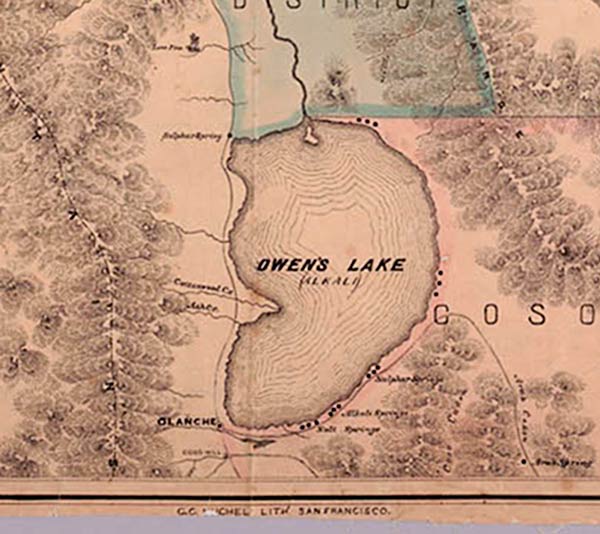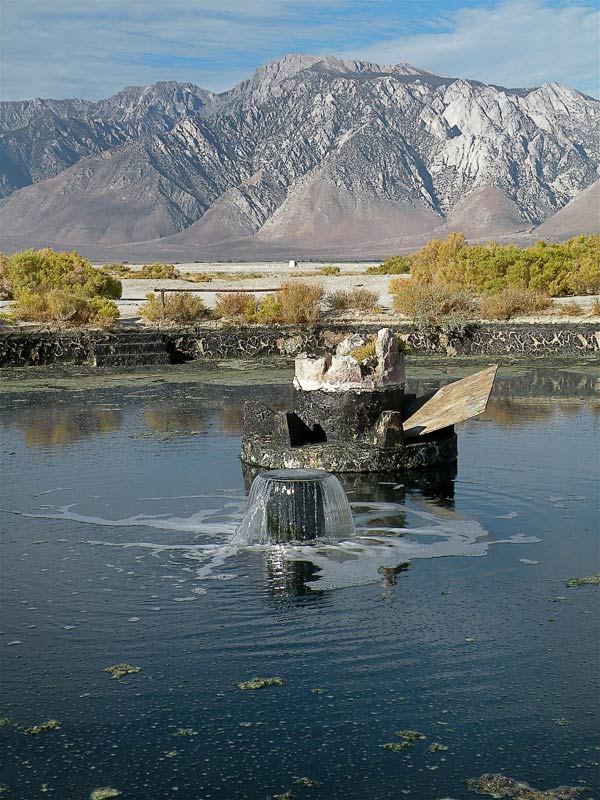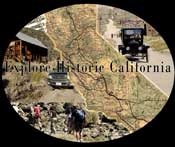Dirty Socks Hot Springs
(Inyo County): Hydrogen sulfide in the water might have
given rise to the name. However, since this odor is
hardly noticeable, the story that the miners washed and
hung their socks in the natural washroom probably
accounts for the name having been given to the place
(Wheelock)
California Place Names: The Origin of Etymology of
Current Geographical Names by
Erwin G. Gudde.
 |
|
Dirty
Sock (s) Hot Springs location can be seen along the
lower right (south east) edge of Owens Lake in this
1864 Holt's Map of the Owens River Mining Country. |
Just southeast of Owens Lake approximately 4½ miles
northeast of the desert hamlet of Olancha lies Dirty Socks
Hot Springs. Today much like the ghost towns hidden in the
towering Inyo Mountains, the location is a shadow of its
former self, and the springs are often littered and bottom
filled with shards of glass, it’s history long forgotten.
Before the white settlers arrived in Owens Valley, Owens
Lake was full of water with pungent scents from non-metallic
minerals including sodium carbonate, borax, and potassium
salts. Together with Indian Wells Valley, Searles Lake,
Panamint Valley and Death Valley, Owens served as a part of
a drainage system that was nearly two hundred feet above the
present valley floor. Around 4,000 years ago geologists say
the Owens River and Owens Lake separated from the system and
became an enclosed basin with no sea outlet, allowing salts
to accumulate. The lake, and nearby hot springs were home to
Native Americans living a relatively peaceful existence off
of the insects and water life that made up the ecosystem of
the area.
The early explorers that first came through the Owens
Valley, found the Native Americans a friendly lot, and were
charmed by their customs, but the settlers that followed
took over their land resulting in battles. Medicine men
performed rituals at Dirty Sock to cure the illnesses that
the white men had brought to their people. Skirmishes took
place at the site and the medicine men were killed. Captain
J. Davidson, of the 1st Dragoons was sent by the
United States government to intervene. Claims were made
that the Native Americans were stealing horses, but Captain
Davidson found them helpful and friendly. Suggestions to
establish an Indian reservation were declined by the United
States government and trouble continued on into the mining
years of the Coso and Cerro Gordo regions.
A 1909 U.S. Geological Survey Water Supply Paper described
the springs; "There are a number of springs near the
southeast edge of Owens Lake, which have long been known to
the stockmen of that region. The springs rise from the
alluvium that surrounds the lake, and the water is brackish.
It is too full of mineral matter to be palatable, but serves
for stock, and is a watering place on the Mohave-Keeler
stage road".
In 1913, a thirsty Los Angeles completed the aqueduct
which diverts the flow of the Owens River from Owens Lake
causing it’s eventual demise. By 1923 the lake was a salt
bed from one to seven feet thick circulating with saturated
brine. The open spaces in the crystal body made up 30 to 35
per cent of the volume and contain the saturated salts.
Precipitation in this land of little rain and underground
springs such as Dirty Socks created the only water in the
massive dry lake bed that once floated two commercial
steamships, the Bessie Brady and Mollie Stevens.
The year 1917 and the first World War brought the need for
soda (sodium carbonate). A well was drilled at Dirty Socks
for recovery of the soda. Warm water gushed through the
casing at 1200 feet. WWI ended and so did the project.
Kitchen and bunk houses were moved to Keeler twenty miles
northeast and the well was left to bubble up naturally.
Scarcity of water for desert travelers created the need
for maps which included watering stops. Dirty Sock appeared
on many of these early maps, marked simply “Springs” “Hot
Springs” or “Artesian Spring” By the 1900’s the name "Dirty
Sock" stuck for the popular camping spot. By 1927 a cement
swimming pool and other structures were built to attract
visitors. By 1945 buildings and dreams of a health spa were
destroyed.
Local Inyo County residents banded together in the 1960’s
to restore the glory days of Dirty Sock. Letters were
written to the Inyo County Board of Supervisors. The area
was surveyed and mapped by the County, the land appraised,
estimates on facility improvements were made, and a
geological survey secured. The report showed an artesian
well flowing a little over two hundred gallons per minute
into a seventy eight foot diameter circular swimming pool
with a temperature of 94 degrees. Sodium and chlorine salts
traced with silica, calcium, and magnesium and sulfates were
found.
An April
1960 article in Desert Magazine described the (then)
conditions; "Each weekend and holiday finds cars loaded with
Dirty Sock devotees. They picnic, camp-out under the sun and
stars or bring their trailers. Many stay for weeks. The
families who vacation at Dirty Sock find richness in the
seeming barrenness of the 45½
acres which comprise The Sock area. Youngsters sculpture in
the clay (Mother uses it for a beauty mask!), collect
sandstone oddities, observe the water-birds by day and the
coyotes, foxes and rabbits by night. The kids play in the
sand, slide down the dunes, roam and explore, swim and grow
healthy and brown. There is no charge, no watchman." (Dirty
Sock, A "for Free" Spa on the Mojave Desert by Marguerite
Jenkins)
The 45.5 acres that contained the area known as Dirty
Socks Springs became a part of an agreement with the Board
of Supervisors and Oliver Thorson, Jean Thorson, Boyd Taylor
and Neil Clark. A lease was drawn for 50 years, or until
otherwise terminated, beginning March 1, 1965. The County
took responsibility for public safety and improvements and
was required to furnish public utilities, clear water,
properly graded road access, comfort stations, dressing
rooms, trees and maintenance of the property. The
maintenance, directional signs, and tree planting proved to
be more than they could handle. Algae took over the pool,
signs were used by visitors for campfire wood, and trees
wouldn’t grow in the saline soil.
 |
|
Dirty
Sock (s) Hot Springs with Olancha Peak in the
background.
Photo
courtesy Michael Prather |
Eventually restrooms and dressing rooms were completed and
the road was graded by Inyo County. The pool was cleaned at
Dirty Sock and post cards revealed an oasis of bathers
complete with sunshine and towering Sierra Nevada Mountains.
The algae, however, remained a problem and a letter appeared
in a column of the Inyo Independent on June 23, 1967,
directed to Earl Greeno, County Recreation Director:
“….lying in the warm water has therapeutic benefits for
people with spinal and other difficulties. Lately, however,
the water is said to take on a deep green coloration at
certain times. Upsetting to the nerves to take a bath,
whether for fun or health in green water. I’m sure that Earl
will clear up the problem, and the water, in short order
even if he has to stand in the pool with a tea strainer to
remove the pigmentation.”
Mr. Greeno’s reply to the concerned citizen appeared in the
July 7, 1967 Inyo Independent:
“I read with a great deal of interest that your column in
the last issue of the Independent about Dirty Sock.
“I wanted you to know that the County did not build the
pool, although we did patch it up, and mend the iron works
and the artesian well part, and also put on a twist-around
pipe at quite an expense to keep the water circulating
around and around, which by the natural pressure coming at
this angle would have kept the ‘green stuff’ out (which I
believe is called algae). However, three times the pipe was
taken off by people using the pool and the only excuse they
gave was that they wanted the Dirty Sock water to come out
to hit their faces and hair for their therapeutic treatment.
As you know, I must bow to the masses or majority of the
people.
“What I did do there was to build the pond that the pool
drains into and also built the road that goes up and around
the pool, and which we expect to have blacktopped in the
near future.
“This algae is really quite a problem being the heaviest
chemical I have ever known, with 6500 solids. I also have
tried to start a tree program there, but with this type of
soil and water conditions, I have not as yet found anything
that will grow, although we have tried at least 30 types of
trees.
“Maybe in the long run your suggestion that I stay down
there with a tea strainer might be the best solution to the
problem.
By October, Lillian Hilderman, Inyo Independent
columnist reported:
“Saturday at 11 a.m., 17 cars and campers containing
Fireball Caravanners from San Fernando…[had] an early
Halloween celebration at the [Dirty Sock} camp where 32
trailers were parked. The pool and grounds were festive
with Fireball flags and lights reflected in the pool,
campfire ready for roasting wieners, buffet carried buns,
various salads, pickles, marshmallows and candy kisses.
“Earl Greeno and myself were Lord Chamberlains to judge
and choose King and Queen of Dirty Sock. Two tin pie plates
cut into points, covered with glitter and pieces of mirror
were clever…..the Queen carried a bouquet of yellow flowered
rabbit brush, not tied with silk or satin ribbon, but a good
grade of cotton string from Galloway’s Store in Olancha.
Amid many flashbulb lighted Kodaks, Mrs. Barry presented the
King and Queen with a shellacked wo0den plaque on which a
single sock had been mounted, cured with a secret formula.
Mr. Greeno spoke at length with interesting data as to how
the pool was acquired, costs, etc. Next came the Haunted
House of Horrors, witches held gruesome things which felt
horrible, with a bucket of blood. (Hours of work of many
persons, but hours of fun for Fireball members, the guests
invited from Olancha, and myself.”
Another
Desert Magazine from November, 1970 still touts the
recreational opportunities at Dirty Sock; "Whatever Dirty
Sock was, today it is a pleasant spa with a swimming pool,
shaded picnic tables and scenery varying from the
snow-tipped, rugged Sierras of southern Inyo County to the
great white expanse of the nearly dry Owens Lake. Man-made
facilities add comforts and a windbreak hut the desert still
edges in and leaves no doubt that 100 years ago the old
pool, reflecting the peaks of the Sierras, was a welcome
sight to any traveler". (Dirty Sock and Beyond by Roberta
Martin Stary)
The glory days of Dirty Socks didn’t last long. Vandalism
continued, with directional signs continuing to be stolen
for firewood, and quickly replaced only to be procured for
firewood all over again. It became so difficult for Inyo
County to keep up with the signs that fences, and bath
houses began to appear. As many dogs as people were
reported using the pool in one complaint to the County. More
signs were put up put up warning visitors to leash dogs and
keep them out of the springs. These signs were also uprooted
and burned. One dog sign was planted in a pipe in the
middle of the pool.
By 1977 rumors began that Dirty Sock was for sale. Several
businesses from oil to mining showed interest. One company
considered turning the area into a commercial campground. By
July of 1978, The Inyo County Board of Supervisors
unanimously voted to terminate the lease as of October 17,
1978.
By 1987, Dirty Sock was a black algae-filled with broken
railings and only warm water bubbles. Trash cans stood
bullet-ridden, with beer cans, bottles scattered on the
desert floor. The remnants of the bath house concrete
foundation contained large red ants dining on a sardine can.
Blackened rock circles of hundreds of campfires were
littered by bird feathers. Few dared to step into the broken
glass therapeutic pool.
Mary
Frances Strong wrote in Desert Magazine, July 1978;
"Stop at Dirty Socks Spring. If your bones are weary, you
will enjoy a dip in the mineral pool. The campground and
pool (no fee) are maintained by Inyo County who, I am sorry
to say, are not doing a very good job. I hope the area has
been cleaned since we were there. (Owens Lake Loop Trip)
In more recent history, Dirty Sock appeared for sale in
local real estate ads. As of this writing, the author of
this story has been able to find out only that the area is
private property. Obey any signage that may appear if
choosing to visit. More information may be obtained at the
Bureau of Land Management.
Some information in this article is based on an article
appearing in The Album: Times & Tales of Inyo-Mono,
“A Dirge For Dirty Sock” by Marguerite Sowaal. December 1987
Chalfant Press, Inc. and from the archives of Desert
Magazine.
